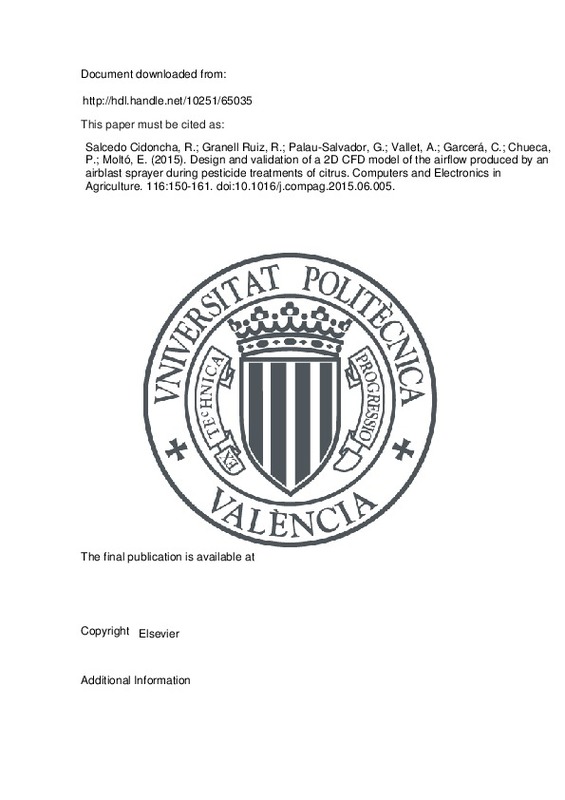JavaScript is disabled for your browser. Some features of this site may not work without it.
Buscar en RiuNet
Listar
Mi cuenta
Estadísticas
Ayuda RiuNet
Admin. UPV
Design and validation of a 2D CFD model of the airflow produced by an airblast sprayer during pesticide treatments of citrus
Mostrar el registro sencillo del ítem
Ficheros en el ítem
| dc.contributor.author | Salcedo Cidoncha, Ramón
|
es_ES |
| dc.contributor.author | Granell Ruiz, Rafael
|
es_ES |
| dc.contributor.author | Palau-Salvador, Guillermo
|
es_ES |
| dc.contributor.author | Vallet, A.
|
es_ES |
| dc.contributor.author | Garcerá, C.
|
es_ES |
| dc.contributor.author | Chueca, Patricia
|
es_ES |
| dc.contributor.author | Moltó, E.
|
es_ES |
| dc.date.accessioned | 2016-06-01T09:14:44Z | |
| dc.date.available | 2016-06-01T09:14:44Z | |
| dc.date.issued | 2015-08 | |
| dc.identifier.issn | 0168-1699 | |
| dc.identifier.uri | http://hdl.handle.net/10251/65035 | |
| dc.description.abstract | [EN] During plant protection treatments using airblast sprayers, part of the chemical is lost in the atmosphere (spray drift), ground, surface water, etc., causing risks to the environment. Although there is a growing interest in quantifying these losses, field measurements are extraordinarily complex and expensive. Computational Fluid Dynamics (CFD) generates mathematical models of this phenomenon that may help to understand and quantify it. The air flow produced by the fan is affected by the tree canopies, which modify the trajectories of spray droplets. Current state of the art in CFD considers canopies as porous bodies and uses the k-epsilon turbulence model. In a first step, this work proposes and validates a two dimensional CFD model to be applied in citrus tree applications from experimental data. This new CFD model considers canopies as solid bodies. Four different geometries for the first tree are compared using three different turbulence models: k-epsilon, SST k-omega and Reynolds Stress Model. Air velocities measured in front of a canopy in a previous field test are introduced as boundary conditions. We used the experimental data to adjust the model and select the geometry and the turbulence model. In order to test the validity of the model, air velocities obtained with the model are compared with the experimental data obtained in other experiment. The final CFD model was able to reproduce the airflow behaviour around the tree canopy, with the same turbulent structures. The solid body with the new turbulence model (SST k-omega) was considered as a good approximation to the real life. (C) 2015 Elsevier B.V. All rights reserved. | es_ES |
| dc.description.sponsorship | This work was partially financed by the Spanish Ministry of Economy (Projects AGL2007-66093-C04-01 and AGL2010-22304-C04-01) and the European Regional Development Fund (ERDF). Ramon Salcedo is recipient of a postgraduate FPI-INIA scholarship. Authors would like to thank to Grupo Martinavarro S.L. for allowing the use of their fields and Pulverizadores Fede S.A. for the use of its sprayer. | en_EN |
| dc.language | Inglés | es_ES |
| dc.publisher | Elsevier | es_ES |
| dc.relation.ispartof | Computers and Electronics in Agriculture | es_ES |
| dc.rights | Reserva de todos los derechos | es_ES |
| dc.subject | Fan | es_ES |
| dc.subject | Spray drif | es_ES |
| dc.subject | Simulation | es_ES |
| dc.subject | Navier-Stokes equations | es_ES |
| dc.subject | RANS models | es_ES |
| dc.subject.classification | INGENIERIA AGROFORESTAL | es_ES |
| dc.title | Design and validation of a 2D CFD model of the airflow produced by an airblast sprayer during pesticide treatments of citrus | es_ES |
| dc.type | Artículo | es_ES |
| dc.identifier.doi | 10.1016/j.compag.2015.06.005 | |
| dc.relation.projectID | info:eu-repo/grantAgreement/MEC//AGL2007-66093-C04-01/ES/REDUCCION DEL USO DE PRODUCTOS FITOSANITARIOS EN CULTIVOS ARBOREOS. GENERACION Y VALIDACION DE MODELOS DE DEPOSICION Y DERIVA PARA EL ESTABLECIMIENTO DE DOSIS OPTIMAS./ | es_ES |
| dc.relation.projectID | info:eu-repo/grantAgreement/MICINN//AGL2010-22304-C04-01/ES/ESTRATEGIAS INTEGRALES PARA UNA UTILIZACION DE FITOSANITARIOS SEGURA Y EFICAZ. GENERACION DE CONOCIMIENTOS SOBRE LOS FENOMENOS DE DERIVA Y APLICACION EN MEDIDAS PALIATIVAS/ | es_ES |
| dc.rights.accessRights | Abierto | es_ES |
| dc.contributor.affiliation | Universitat Politècnica de València. Departamento de Ingeniería Rural y Agroalimentaria - Departament d'Enginyeria Rural i Agroalimentària | es_ES |
| dc.description.bibliographicCitation | Salcedo Cidoncha, R.; Granell Ruiz, R.; Palau-Salvador, G.; Vallet, A.; Garcerá, C.; Chueca, P.; Moltó, E. (2015). Design and validation of a 2D CFD model of the airflow produced by an airblast sprayer during pesticide treatments of citrus. Computers and Electronics in Agriculture. 116:150-161. https://doi.org/10.1016/j.compag.2015.06.005 | es_ES |
| dc.description.accrualMethod | S | es_ES |
| dc.description.upvformatpinicio | 150 | es_ES |
| dc.description.upvformatpfin | 161 | es_ES |
| dc.type.version | info:eu-repo/semantics/publishedVersion | es_ES |
| dc.description.volume | 116 | es_ES |
| dc.relation.senia | 308264 | es_ES |
| dc.identifier.eissn | 1872-7107 | |
| dc.contributor.funder | Ministerio de Educación y Ciencia | es_ES |
| dc.contributor.funder | Ministerio de Ciencia e Innovación | es_ES |
| dc.contributor.funder | European Regional Development Fund | es_ES |
| dc.contributor.funder | Instituto Nacional de Investigación y Tecnología Agraria y Alimentaria | es_ES |







![[Cerrado]](/themes/UPV/images/candado.png)

